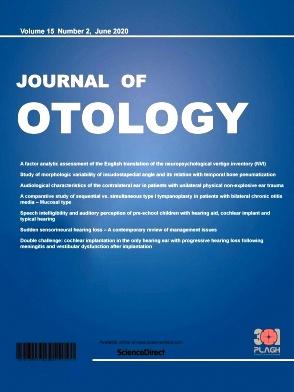视觉增强前庭-眼反射与视频头脉冲测试在前庭评估中的比较。
IF 1.4
Q2 OTORHINOLARYNGOLOGY
引用次数: 0
摘要
目的:本研究旨在开发和评估一种新的软件工具,用于视觉增强前庭-眼反射(VVOR)和视频头脉冲测试(vHIT)跳频的稳健分析。方法:对94例梅尼埃病(MD)合并单侧前庭功能减退(UVH)和前庭偏头痛(VM)患者进行回顾性研究。利用基于matlab的VVOR分析系统和Saccades All in One软件进行数据处理。采用VVOR_diff和VVOR_cycle新技术提取眼动参数。结果:通过vHIT、VVOR_diff和VVOR_cycle检测,眼跳发生率在MD、UVH和VM患者中表现出不同的模式。在一个周期内,MD和UVH患者患侧经常出现多次扫视。在MD和UVH患者中,受影响侧和未受影响侧的扫视增益和发病率有统计学上的显著差异。值得注意的是,方法间和方法内的高度相关性表明不同方法之间的一致性和一种方法内部潜在的相互作用。结论:该软件可有效提取VVOR数据中的眼跳和降低噪声,从而增强对前庭功能的评估,有可能提高前庭功能障碍的诊断准确性。本文章由计算机程序翻译,如有差异,请以英文原文为准。
Comparing saccades in Visually Enhanced Vestibular-Ocular Reflex and video head impulse test in vestibular assessment
Objective
This study aimed to develop and evaluate a novel software tool for robust analysis of the Visually Enhanced Vestibular-Ocular Reflex (VVOR) and video head impulse test (vHIT) saccades.
Methods
A retrospective study was conducted on 94 patients with Meniere's Disease (MD), unilateral vestibular hypofunction (UVH), and vestibular migraine (VM). The MATLAB-based VVOR Analysis System and Saccades All in One software were utilized for data processing. New techniques, VVOR_diff and VVOR_cycle, were deployed for saccade parameter extraction.
Results
Saccade incidence rates, examined through vHIT, VVOR_diff, and VVOR_cycle, exhibited distinct patterns in MD, UVH, and VM patients. Frequent instances of multiple saccades within a single cycle were noted on the affected side in MD and UVH patients. Statistically significant differences in saccade gain and incidence rates between the affected and unaffected sides were evident in MD and UVH patients. Notably, high inter-method and intra-method correlations suggested consistency across different methods and potential interactions within one.
Conclusion
The software proved effective in extracting saccades and reducing noise in VVOR data, thereby enhancing the evaluation of vestibular function and potentially improving diagnostic accuracy for vestibular disorders.
求助全文
通过发布文献求助,成功后即可免费获取论文全文。
去求助
来源期刊

Journal of Otology
Medicine-Otorhinolaryngology
CiteScore
2.70
自引率
0.00%
发文量
461
审稿时长
18 days
期刊介绍:
Journal of Otology is an open access, peer-reviewed journal that publishes research findings from disciplines related to both clinical and basic science aspects of auditory and vestibular system and diseases of the ear. This journal welcomes submissions describing original experimental research that may improve our understanding of the mechanisms underlying problems of basic or clinical significance and treatment of patients with disorders of the auditory and vestibular systems. In addition to original papers the journal also offers invited review articles on current topics written by leading experts in the field. The journal is of primary importance for all scientists and practitioners interested in audiology, otology and neurotology, auditory neurosciences and related disciplines. Journal of Otology welcomes contributions from scholars in all countries and regions across the world.
 求助内容:
求助内容: 应助结果提醒方式:
应助结果提醒方式:


